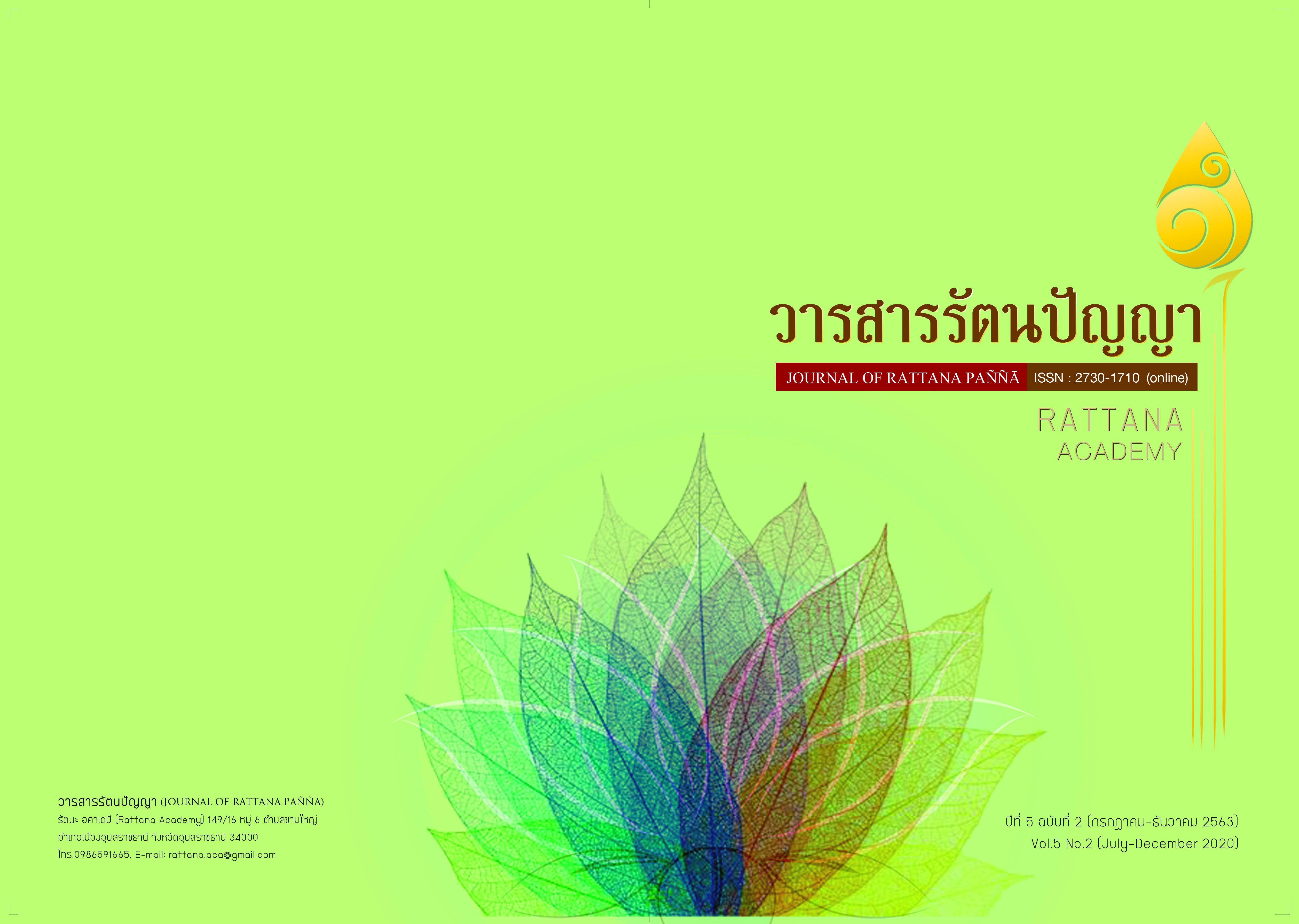Food Tourism in a Society and Cultural Diversity :Thailand and Malaysia
Main Article Content
Abstract
Food tourism is one of niche tourism that is popular for the tourists in the world because of it is related to the natural resource management, social and cultural. For the behavior of tourist characteristics, they are interested in culture and learning to gain a new experience. This academic article is to demonstrate about food tourism activities from the phenomenon of food tourism occurrences which used a document analysis method that related to the food tourism management between Thailand and Malaysia where are difference cultural. The synthesis based on keywords and year of published from 2009 to present. The result shows that food tourism management in Thailand is linked to the food culture that is caused by regional division, natural resources, ethnic and religious. The outstanding food tourism model in Thailand is as follows; 1) Street food tourism 2) Food festival tourism and 3) local food tourism. As for food tourism management in Malaysia is linked to the food culture which passed from 3 ethnics, natural resources and religious. On the other hand, the best food tourism program in Malaysia is as follows; 1) Slow food tourism 2) local food tourism 3) gastronomy tourism and 4) Halal tourism. However, it also found the lack of needs in food tourism management for both countries are food tourism product development and marketing strategy development.
Article Details
References
ญาณภา บุญประกอบ, จักรวาล วงศ์มณี, ศิริพร เขตเจน และ โยธิน แสวงดี. (2560). การอาหารพื้นถิ่นกับกลไกในการส่งเสริมการท่องเที่ยวเชิงสร้างสรรค์: กรณีศึกษากลุ่มชาติพันธุ์ลาวครั่ง จังหวัดชัยนาท. วารสารวิทยาลัยดุสิตธานี, 11(ฉบับพิเศษ), 93-108.
ญาดา ชอบทำดี และนรินทร์ สังข์รักษา. (2562). รูปแบบการท่องเที่ยวเชิงอาหารพื้นถิ่นชายฝั่งทะเลภาคตะวันออก. วารสารวิทยาลัยดุสิตธานี, 13(2), 403-413.
ณัฐธิดา สุวรรณโณ และสุวิทย์ สุวรรณโณ. (2555). โมบายล์แอพพลิเคชั่นระบบสืบค้นและเรียนรู้อัตลักษณ์อาหารพื้นถิ่นภาคใต้บนระบบปฏิบัติการแอนดรอยด์. รายงานการวิจัย โครงการตามแผนพัฒนาลุ่มน้ำทะเลสาบสงขลา คณะการจัดการสิ่งแวดล้อม มหาวิทยาลัยสงขลานครินทร์.
ดวงกมล การไทย. (2559). ฐานข้อมูลสังคม–วัฒนธรรมเอเชียตะวันออกเฉียงใต้. (ออนไลน์) (อ้างเมื่อ 4 เมษายน 2563. จาก https://www.sac.or.th/databases/southeastasia/subject_pdf.php
เบญจมาภรณ์ ชำนาญฉา. (2561). Gastronomy Tourism: Thailand’s Competitiveness. สมาคมสถาบันอุดมศึกษาเอกชนแห่งประเทศไทย ในพระราชูปถัมภ์สมเด็จพระเทพรัตนราชสุดาฯ สยามบรมราชกุมารี, 24(1), 103-116.
เบญจมาศ ณ ทองแก้ว, ธาราทิพย์ เกิดสุวรรณ์, จิรัชยา ปรีชาชน และอำนาจ รักษาพล. (2560). การท่องเที่ยวเชิงอาหารตลาดใต้เคี่ยม จังหวัดชุมพร. วารสารวิจัยเพื่อการพัฒนาเชิงพื้นที่, 9(6), 458-470.
พระราชเขมากร. (2561). อาหารพื้นบาน: กระบวนการจัดการเพื่อคุณภาพชีวิตและจริยธรรมทางสังคม. วารสารบัณฑิตศึกษาปริทรรศน มจร วิทยาเขตแพร, 4(2), 131-148.
พิมพ์ระวี โรจน์รุ่งสัตย์. (2556). ความสําคัญและกิจกรรมสื่อสารเรียนรู้จากการท่องเที่ยว “อาหาร” สําหรับนักท่องเที่ยวกลุ่มตลาดผู้หญิงชาวต่างประเทศของไทย. วารสารการบริการและการท่องเที่ยวไทย, 8(1), 61-72.
พิมพ์พิสุทธิ์ อ้วนล้ำ, ชมพูนุท โมราชาติ และกัญญา จึงวิมุติพันธ์. (2560). การพัฒนาศักยภาพการดําเนินงานกลุ่มหนึ่งตำบลหนึ่งผลิตภัณฑ์ (โอทอป) ประเภทสมุนไพรที่ไม่ใช่อาหาร. วารสารมนุษยศาสตร์และสังคมศาสตร์, 8(2), 207-238.
ภาณุวัฒน์ ภักดีอักษร. (2555). ทฤษฎีแรงจูงใจการท่องเที่ยวกับการท่องเที่ยวเชิงอาหาร. วารสารวิทยาการจัดการ, 29(2), 129-148.
ภัทรพร พันธุรี. (2558). การจัดกิจกรรมการท่องเที่ยวเชิงอาหารโดยผ่านประสบการณ์ของนักท่องเที่ยวในประเทศไทย. วารสารเทคโนโลยีภาคใต้, 8(2), 27-37.
สาริกา ค้าสุวรรณ. (2555). ภาพลักษณ์อาหารฮาลาลไทยในกลุ่มผู้บริโภคมุสลิมตะวันออกกลาง. BU Academic Review, 11(1), 1-17.
สำนักงานสถิติแห่งชาติ. (2561). สภาวะทางสังคม วัฒนธรรมและสุขภาพจิต ปี 2561. (ออนไลน์) (อ้างเมื่อ 4 เมษายน 2563). จาก http://www.nso.go.th/sites/2014/Pages/News/2561/N21-09-61-1.aspx
องค์การบริหารการพัฒนาพื้นที่พิเศษเพื่อการท่องเที่ยวอย่างยั่งยืน. (2559). ท่องเที่ยวเชิงอาหาร. กรุงเทพมหานคร: โคคูน แอนด์ โค.
อรอนงค์ ทองมี. (2558). วัฒนธรรมอาหารล้านนา: การพัฒนาเชิงเศรษฐกิจสร้างสรรค์. วารสารศิลปกรรมศาสตร์วิชาการ วิจัยและงานสร้างสรรค์ ราชมงคลธัญบุรี, 2(1), 25-54.
Association of Southeast Asian Nations. (2017). Tourist arrivals in ASEAN. (online) (Retrieved April 4, 2020). from https://asean.org/wp-content/uploads/2015/09/Table-28-checked.pdf
Chaigasem, T. and Tunming, P. (2019). A local cuisine tourism approach to authenticity and a sense of place for Postmodern gastronomy in I-SAN Thailand. African Journal of Hospitality, Tourism and Leisure, 8, 1-14.
Chi, C.G.-Q., Chua, B.L., Othman, M. and Karim, S.A. (2013). Investigating the structural relationships between food image, food satisfaction, culinary quality, and behavioural intentions: the case of Malaysia. International Journal of Hospitality & Tourism Adminstration, 14(2), 99-120.
Ellisa, A., Parkb, E., Kimc, S. and Yeomanb, L. (2018). What is food tourism
. Tourism Management, 68, 250–263.
Fatemeh, S. and Badaruddin, M. (2015). Malaysia’s branding as an Islamic tourism hub: An assessment. Malaysia Journal of Society and Space, 11(1), 97–106.
Folorunso, S., Ojo, A. and Lattimore, K. C. (2013). Slow food events as a high yield strategy for rural tourism destinations. Worldwide Hospitality and Tourism Themes, 5(4), 353-364.
Forné, F.F. (2015). Food tourism: Authenticity and local development in rural areas. Documents d’Anàlisi Geogràfica, 6(1), 289-304.
Jalis, H., Salehuddin, M., Zahari, M., Zulkifly, I. M. and Othman, Z. (2009). Malaysian Gastronomic Tourism Products: Assessing the Level of their Acceptance among the Western Tourists. South Asian Journal of Tourism and Heritage, 2(1), 31-44.
Jenasama, S. and Madhuri, S. (2018). Creative Tourism through food activities in Thailand. International Journal of Management and Economics, 26(1), 25-30.
Karim, S. M., Chua, L. B. and Salleh, H. (2009). Malaysia As A Culinary Tourism Destination: International Tourists’ Perspective. Journal of Tourism, Hospitality & Culinary Arts, 63-78.
Khan, F. and Callanan, M. (2017). The “Halalification” of tourism. Journal of Islamic Marketing, 8(4), 558-577.
Mitchell, R. and Hall, M. C. (2003). Consuming tourism: food tourism consumer behavior: Food Tourism Around the World. Burlington: Elsevier.
Nahar, N., Karim, M., Karim, R., Mohd, G. H. and Krauss, S. (2018). The Globalization of Malaysia National Cuisine: A Concept of Gastrodiplomacy. Journal of Tourism, Hospitality & Culinary Arts, 10(1), 42-58.
Northcote, J. and Macbeth, J. (2006). Conceptualising yield: sustainable tourism management. Annals of Tourism Research, 33(1), 199-220.
Rahman, S. M., Zaman, H. M., Hassan, H. and Wei, C. C. (2018). Tourist’s preferences in selection of local food: perception and behavior embedded model. Tourism Review, 73(1), 111-126.
Rahman, S. M., Moghavvemi, S., Thirumoorthi, T. and Rahman, K. M. (2019). The impact of tourists’ perceptions on halal tourism destination: a structural model analysis. Tourism Review, 2, Abstract retrieved April 3, 2020, from ResearchGate database.
Seasia Good News from Southeast Asia. (2019). Tourist Arrival to ASEAN Countries 2019 Reaches 133 Million. (online) (Retrieved April 4, 2020). from https://seasia.co/2020/02/11/revealed-tourist-arrival-to-asean-countries-2019
Stanley, J. and Stanley, L. (2014). Food Tourism A Practical Marketing Guide. Boston: CAB International.
Thailand Convention and Exhibition Bureau. (2019). The Future of Food Tourism in Thailand. (online) (Retrieved April 4, 2020). from https://skift.com/2019/11/15/the-future-of-food-tourism-in-thailand/


